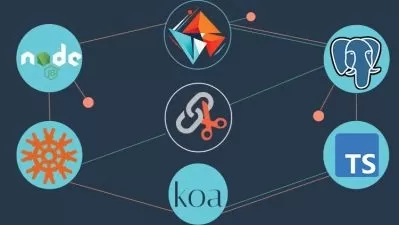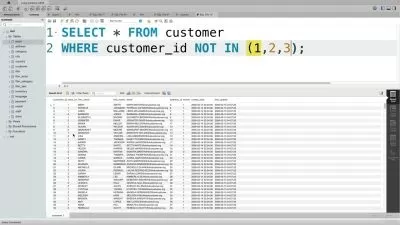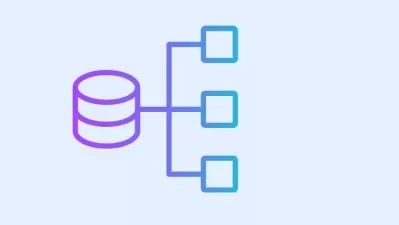The Complete Beginner to Advanced PostgreSQL Course 2024
Hoang Quy La
6:18:16
Description
Database Design Principles, Normalization, Entity relationship modelling, Common table expressions (CTES), ACLs, RLs
What You'll Learn?
- pgAdmin4
- create and delete a database
- data types
- primary keys
- operators
- functions
- Database Design Principles
- Normalization
- References keywords
- Entity relationship modelling
- one to one relationship
- one to many relationship
- Many to many relationship
- Constraints
- indexes
- transactions
- filter
- sort
- join
- like
- ilike
- distinct
- subqueries
- Not exists
- exists
- having
- upsert
- Common table expressions (CTES)
- Rank function
- window function
- procedure
- Recursive queries
- User management and permissions
- How to create users and roles
- ACLs
- list all users and roles
- RLs
- Transaction Isolation
- MVCC
- Savepoints
- Deadlocks
- Vacuumm
- explain statement
- query tuning
- Analyze keyword
- Variables, constrol structure, if-then-else, case statement, for-loop, while-loop, error tyoes, exception handling.
- functions, cursors, Raise, procedures, triggers
- Dynamic SQL concepts, SQL injections
- lock, table-level-lock, AccessShareLock, RowShareLock, RowExclusiveLock, ShareLock, ExclusiveLock, AccessExclusiveLock, Database-level locks, Explicit Lock.
Who is this for?
What You Need to Know?
More details
DescriptionWelcome to "The Complete Introduction to PostgreSQL Course 2024" on Udemy! Whether you're a beginner looking to learn the fundamentals of PostgreSQL or an experienced professional seeking to enhance your database management skills, this course is designed to provide you with a comprehensive understanding of PostgreSQL, one of the most powerful open-source relational database management systems (RDBMS) available today.
In this course, you will embark on a journey through the core concepts of PostgreSQL, starting with an introduction to relational databases and SQL (Structured Query Language). You will learn how to install PostgreSQL, set up databases, and perform basic SQL commands to query and manipulate data effectively.
As you progress, you will delve into more advanced topics, including database design principles, normalization, and entity-relationship modeling. You will explore PostgreSQL's rich feature set, including data types, constraints, and functions, and learn how to harness the power of SQL for data analysis and manipulation.
Throughout the course, you can apply your knowledge through hands-on exercises and real-world examples. You will gain practical experience in creating tables, designing schemas, writing stored procedures, and implementing triggers to automate tasks and enforce data integrity.
By the end of this course, you will have a solid understanding of PostgreSQL and the skills to work confidently with databases in various roles, including database administration, software development, data analysis, and more. Whether building applications, managing data, or exploring new career opportunities, "The Complete Introduction to PostgreSQL Course 2024" will equip you with the knowledge and tools you need to succeed.
Below are topics covered in this course:
Data types and operators.
Primary keys.
Operators and functions.
Reference keywords.
one-one relationship.
one-to-many relationship
Many-to-many relationship.
Constraints
Indexes.
transactions.
Filter
Sort
Join
Like
ILIKE
Distinct
limit and offset
subqueries
not exists
exists
having
upsert
How to add a new column
CTE (Common table expression)
Window function
RANK() function
Procedure
Recursive Queries
User Management and permissions
users and roles
ACLs
list users and roles
Row-level security
transaction Isolation
MVCC
Savepoints
Deadlocks
Vacuumm
Explain statement
query tuning
Analyze keywords
Variables, constrol structure, if-then-else, case statement, for-loop, while-loop, error tyoes, exception handling.
functions, cursors, Raise, procedures, triggers
Dynamic SQL concepts, SQL injections
lock, table-level-lock, AccessShareLock, RowShareLock, RowExclusiveLock, ShareLock, ExclusiveLock, AccessExclusiveLock, Database-level locks, Explicit Lock.
Enroll now and take the first step towards mastering PostgreSQL! Let's dive into the world of databases together.
Take advantage of this opportunity to learn PostgreSQL from industry experts. Enroll now and unlock the full potential of PostgreSQL for your projects and career aspirations!
Who this course is for:
- Individuals who are new to databases and want to learn the fundamentals of PostgreSQL from scratch.
- Professionals responsible for managing and maintaining databases who wish to enhance their knowledge and skills in PostgreSQL administration.
- Programmers who want to integrate PostgreSQL into their applications or learn how to interact with databases using SQL and PostgreSQL-specific features.
- Those interested in working with large datasets, analyzing data, and gaining insights using PostgreSQL's analytical capabilities.
- Students pursuing degrees in computer science, information technology, or related fields, as well as individuals interested in databases as a hobby or for personal projects.
Welcome to "The Complete Introduction to PostgreSQL Course 2024" on Udemy! Whether you're a beginner looking to learn the fundamentals of PostgreSQL or an experienced professional seeking to enhance your database management skills, this course is designed to provide you with a comprehensive understanding of PostgreSQL, one of the most powerful open-source relational database management systems (RDBMS) available today.
In this course, you will embark on a journey through the core concepts of PostgreSQL, starting with an introduction to relational databases and SQL (Structured Query Language). You will learn how to install PostgreSQL, set up databases, and perform basic SQL commands to query and manipulate data effectively.
As you progress, you will delve into more advanced topics, including database design principles, normalization, and entity-relationship modeling. You will explore PostgreSQL's rich feature set, including data types, constraints, and functions, and learn how to harness the power of SQL for data analysis and manipulation.
Throughout the course, you can apply your knowledge through hands-on exercises and real-world examples. You will gain practical experience in creating tables, designing schemas, writing stored procedures, and implementing triggers to automate tasks and enforce data integrity.
By the end of this course, you will have a solid understanding of PostgreSQL and the skills to work confidently with databases in various roles, including database administration, software development, data analysis, and more. Whether building applications, managing data, or exploring new career opportunities, "The Complete Introduction to PostgreSQL Course 2024" will equip you with the knowledge and tools you need to succeed.
Below are topics covered in this course:
Data types and operators.
Primary keys.
Operators and functions.
Reference keywords.
one-one relationship.
one-to-many relationship
Many-to-many relationship.
Constraints
Indexes.
transactions.
Filter
Sort
Join
Like
ILIKE
Distinct
limit and offset
subqueries
not exists
exists
having
upsert
How to add a new column
CTE (Common table expression)
Window function
RANK() function
Procedure
Recursive Queries
User Management and permissions
users and roles
ACLs
list users and roles
Row-level security
transaction Isolation
MVCC
Savepoints
Deadlocks
Vacuumm
Explain statement
query tuning
Analyze keywords
Variables, constrol structure, if-then-else, case statement, for-loop, while-loop, error tyoes, exception handling.
functions, cursors, Raise, procedures, triggers
Dynamic SQL concepts, SQL injections
lock, table-level-lock, AccessShareLock, RowShareLock, RowExclusiveLock, ShareLock, ExclusiveLock, AccessExclusiveLock, Database-level locks, Explicit Lock.
Enroll now and take the first step towards mastering PostgreSQL! Let's dive into the world of databases together.
Take advantage of this opportunity to learn PostgreSQL from industry experts. Enroll now and unlock the full potential of PostgreSQL for your projects and career aspirations!
Who this course is for:
- Individuals who are new to databases and want to learn the fundamentals of PostgreSQL from scratch.
- Professionals responsible for managing and maintaining databases who wish to enhance their knowledge and skills in PostgreSQL administration.
- Programmers who want to integrate PostgreSQL into their applications or learn how to interact with databases using SQL and PostgreSQL-specific features.
- Those interested in working with large datasets, analyzing data, and gaining insights using PostgreSQL's analytical capabilities.
- Students pursuing degrees in computer science, information technology, or related fields, as well as individuals interested in databases as a hobby or for personal projects.
User Reviews
Rating
Hoang Quy La
Instructor's Courses
Udemy
View courses Udemy- language english
- Training sessions 53
- duration 6:18:16
- Release Date 2024/07/26













